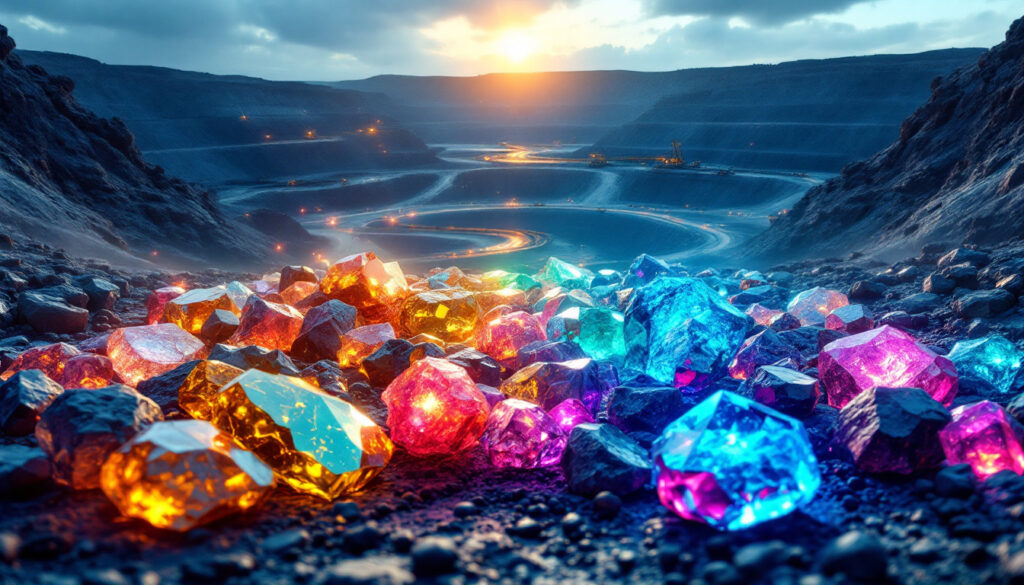Why Is Rio Tinto Considering Rare Earths?
The global mining giant Rio Tinto is making strategic moves toward the rare earths sector as part of a broader portfolio diversification strategy. CEO Jakob Stausholm recently confirmed that the company's board has specifically discussed rare earth potential, indicating a serious consideration of these critical minerals within Rio Tinto's future plans.
"Critical minerals are often present in our existing operations as a by-product. It's a question of whether we should process them more deliberately," Stausholm noted, highlighting the company's pragmatic approach to entering this specialized market.
Global Market Dynamics Driving Strategic Shifts
Rio Tinto's interest comes amid increasing geopolitical tensions and growing concerns about supply chain security for these vital materials. With rare earths being essential components in technologies ranging from electric vehicles to defense systems, their strategic importance has never been higher.
The company's approach differs significantly from traditional market entry strategies. Rather than developing dedicated rare earth mines—which would require substantial capital investment and lengthy permitting processes—Rio Tinto is exploring opportunities to extract critical minerals as by-products from its existing operations.
Leveraging Existing Operations for Critical Minerals
Rio Tinto already produces scandium as a by-product of titanium dioxide production at its operations in Quebec, with an annual capacity of approximately 3 tonnes. This facility, which became North America's first scandium producer in 2021, employs a pioneering electrolysis process to extract scandium from titanium dioxide slag.
Additionally, the company is evaluating gallium extraction from its aluminum operations. Gallium, critical for semiconductors and LED manufacturing, represents another opportunity to tap into the critical minerals race without significant new infrastructure investment. This approach is particularly relevant given China's control of approximately 80% of global gallium production, highlighting the supply chain vulnerabilities Rio Tinto could help address.
The company achieves approximately 70% recovery rates for scandium from its Quebec operations, with ongoing work to optimize this process further. This technical expertise gives Rio Tinto a potential competitive advantage in the critical minerals space.
How Does This Fit Into Rio Tinto's Broader Strategy?
Rio Tinto's exploration of rare earths and other critical minerals represents a calculated diversification move that complements its core business while positioning the company for future growth markets.
Portfolio Diversification Beyond Traditional Commodities
While Rio Tinto's Pilbara iron ore operations contributed a staggering 90% of the company's $10.8 billion EBITDA in 2024, the company recognizes the importance of expanding beyond its traditional strongholds. The company continues to optimize these iron ore operations while simultaneously advancing the massive Simandou project in Guinea, which aims to produce 100 million tonnes of iron ore annually by 2028.
However, Chairman Dominic Barton has emphasized that "by-product processing minimizes capital risks while diversifying revenue," indicating the strategic rationale behind the critical minerals push. This approach allows Rio Tinto to hedge against volatility in its primary commodities while capitalizing on growing demand for materials essential to the clean energy revolution in mining.
By-product Processing as a Strategic Advantage
Rio Tinto has already demonstrated success with the by-product model at operations like its Oyu Tolgoi copper mine in Mongolia, where gold and silver extraction contributes approximately 12% of the site's revenue. This multi-mineral approach maximizes value from existing assets while minimizing additional capital expenditure.
The company's capabilities in by-product processing extend beyond rare earths. Its joint venture with Alcoa called Elysis is developing technology that eliminates carbon emissions in aluminum smelting—an innovation that could revolutionize the industry while potentially enabling more efficient recovery of associated critical minerals.
The International Energy Agency estimates that demand for rare earths used in permanent magnets for electric vehicles and wind turbines could increase by 600% by 2040, creating substantial market opportunities for producers who can establish reliable supply chains outside China.
What Challenges Does Rio Tinto Face in the Rare Earths Market?
Despite the strategic rationale, Rio Tinto faces significant challenges in establishing a meaningful presence in the rare earths market.
Market Structure and Demand Certainty
Unlike Rio Tinto's traditional commodity markets, rare earths lack centralized exchanges and transparent spot market mechanisms. Prices are typically negotiated through long-term contracts, creating uncertainty around market dynamics and return on investment.
"The absence of robust spot markets for many critical minerals necessitates confirmed demand before scaling up production," Stausholm explained. This market structure requires Rio Tinto to secure offtake agreements before committing significant resources to rare earth extraction and processing.
The critical minerals market, valued at approximately $12 billion in 2025, is dwarfed by iron ore's $140 billion market. This scale disparity explains why major miners have historically avoided significant investments in this space, despite the strategic importance of these materials.
Scale Considerations and Economic Viability
Chairman Dominic Barton acknowledged this challenge directly, noting that "top miners avoid critical minerals due to limited scale and complexity." The processing complexity for rare earths illustrates this point clearly—rare earth separation involves 15-20 processing steps compared to just 3-5 steps for base metals.
Additionally, the high purity standards required for rare earth applications (such as 99.99% purity for neodymium used in permanent magnets) significantly complicate refining processes and increase production costs.
The industry has seen cautionary tales, like Lynas Rare Earths' $800 million expansion that stalled due to permitting delays in 2022, and MP Materials' 30% revenue drop in 2023 due to price volatility. These examples highlight the risks Rio Tinto must navigate in this specialized market.
"The rare earths market requires specialized knowledge and significant technical capabilities," notes industry analyst Ming Chen. "Rio Tinto's approach of leveraging existing operations rather than greenfield development significantly reduces entry barriers and financial risks."
How Do Global Trade Tensions Impact Rio Tinto's Strategy?
Global trade tensions, particularly between China and Western nations, create both challenges and opportunities for Rio Tinto's critical minerals strategy.
Navigating the Tariff Landscape
U.S. tariffs on Chinese rare earths currently stand at 25% and are set to rise to 35% by 2025. Meanwhile, the European Union's Critical Raw Materials Act mandates 20% domestic rare earth sourcing by 2030. These policy shifts create potential market openings for non-Chinese suppliers like Rio Tinto.
While not enthusiastic about trade barriers, Barton expressed confidence in Rio Tinto's competitive position: "We'll compete under uniform tariffs due to cost-curve advantages." This statement reflects the company's belief in its operational efficiency regardless of trade policy environments.
Recent examples from other commodity markets illustrate the potential impacts of such policies. Chile's 2024 lithium nationalization disrupted operations for major producers SQM and Albemarle, while Indonesia's nickel export ban in 2023 significantly increased processing investments within that country.
Supply Chain Diversification Opportunities
The global push for supply chain diversification, particularly for materials deemed strategically important, creates new opportunities for Rio Tinto. The company's geographic diversification across stable jurisdictions positions it well to meet Western nations' growing demand for secure critical mineral sources.
Stausholm noted that the Resolution copper project in Arizona has received expedited permitting from U.S. authorities—a process that typically takes ten years compressed to a three-year fast-track timeline. This acceleration signals growing government support for domestic critical mineral production, potentially benefiting Rio Tinto's North American operations.
What Are Rio Tinto's North American Opportunities?
North America represents a particularly promising region for Rio Tinto's critical minerals strategy, with supportive government policies and existing operational footprints.
Canadian Operations and Political Context
Rio Tinto maintains significant operations in Canada, employing approximately 10,000 workers in its aluminum business alone. Barton welcomed recent Canadian election results, suggesting they provide continued support for resource development policies.
The Canadian government has demonstrated commitment to critical minerals development through initiatives like the $3.8 billion Critical Minerals Infrastructure Fund established in 2024. Quebec's $1 billion investment in aluminum R&D between 2023 and 2026 further supports Rio Tinto's position in the region.
"Canada recognizes aluminum's economic importance," Barton emphasized, highlighting the alignment between national priorities and Rio Tinto's operations. This political support creates a favorable environment for expanding critical mineral production from existing operations.
Expanding U.S. Presence
Rio Tinto maintains significant operations in the United States that could serve as platforms for critical minerals development:
- Kennecott copper mine and smelter in Utah: Producing approximately 200,000 tonnes of copper annually with 98% sulfur capture efficiency, this operation has reportedly secured a 2025 offtake agreement with Tesla
- Boron mine in California: Supplying approximately 40% of U.S. boron needs
- Resolution copper project in Arizona: A joint venture with BHP containing an estimated 40 billion pounds of copper reserves
Stausholm specifically noted strong U.S. government interest in maximizing output from Rio's American assets, with the Resolution project recently receiving expedited permitting. This shift in the regulatory approach to mining development reflects increasing recognition of critical minerals' strategic importance.
The company's U.S. operations benefit from provisions in the Inflation Reduction Act that incentivize domestic mineral production and processing for clean energy applications—advantages not available to the same degree in other jurisdictions.
How Do Critical Minerals Support Rio Tinto's Social License?
Beyond commercial considerations, Rio Tinto's critical minerals strategy also supports its broader social license to operate—an increasingly important factor for major mining companies.
Strengthening Community Relations
Barton specifically mentioned that critical minerals could enhance Rio Tinto's social license to operate, noting the observation that "those with fewer resources are often the most vocal" in community engagement contexts. This perspective suggests that critical minerals development, with its connection to clean energy technologies, may face less community opposition than traditional mining activities.
The company has been working to rebuild trust following the 2020 Juukan Gorge incident in Australia, where culturally significant caves were destroyed during mine expansion. The focus on critical minerals essential for clean energy applications provides an opportunity to reframe the company's narrative around positive contributions to global sustainability goals.
Alignment with Sustainability Goals
Critical minerals essential for renewable energy technologies and electrification align with Rio Tinto's broader sustainability objectives. These materials enable technologies that reduce carbon emissions—from electric vehicles to wind turbines—positioning Rio Tinto as a contributor to climate solutions rather than just a resource extractor.
This alignment can positively impact the company's ESG ratings, with S&P Global ESG scores increasingly influencing investment decisions. By expanding its critical minerals portfolio, Rio Tinto potentially improves its standing with sustainability-focused investors and stakeholders.
"Mining companies that can demonstrate their critical role in enabling the energy transition through responsible sourcing of critical minerals have an opportunity to fundamentally reshape public perception," notes sustainability consultant Dr. Emma Richardson.
What Is Rio Tinto's Perspective on China's Market Position?
China's dominance in rare earths processing and growing trade tensions with Western nations significantly influence Rio Tinto's strategy in this sector.
Long-term Economic Resilience
Drawing on his experience as a former Canadian ambassador to China, Barton suggested China's economy could absorb short-term tariff impacts. He pointed to ongoing urbanization, GDP consumption rates, and green infrastructure investment as factors supporting long-term demand for materials like steel and, by extension, iron ore.
Despite recent economic challenges, China's commitment to renewable energy development—including installing approximately 70% of the world's new wind capacity in 2023—suggests continued strong demand for critical minerals like rare earths, regardless of trade tensions.
Market Equilibrium Expectations
Despite near-term market disruptions, Rio Tinto anticipates a new equilibrium will emerge in global markets. The company maintains a strategic focus on long-term demand fundamentals rather than short-term trade tensions, recognizing that critical minerals will remain essential for technological development regardless of geopolitical fluctuations.
While China's critical mineral export restrictions currently control approximately 85% of global rare earth processing capacity, new projects are emerging in Australia, the United States, and Canada that may gradually diversify the supply chain. Rio Tinto's by-product approach could accelerate this diversification by leveraging existing infrastructure rather than requiring entirely new processing facilities.
How Has Rio Tinto Addressed Corporate Structure Challenges?
While pursuing its critical minerals strategy, Rio Tinto has simultaneously defended its existing corporate structure against activist pressure.
Failed Activist Campaign
A proposal from UK-based hedge fund Palliser Capital to force a review of Rio's dual-listed company structure recently failed to gain significant shareholder support. Only 19.35% of shareholders voted in favor—below the 20% threshold that would have required further engagement on the issue.
This outcome demonstrates shareholder confidence in the company's current direction and leadership, providing management with a mandate to pursue strategic initiatives like critical minerals development without the distraction of corporate restructuring.
Board's Position on Dual Listing
Barton defended the current structure, stating that a comprehensive review with five external consultants had concluded that unifying the dual-listed company would be "value destructive for the group and its shareholders."
The dual-listed structure, which maintains separate legal entities on the London and Australian stock exchanges while operating as a unified business, provides tax efficiency and market access advantages that outweigh potential simplification benefits, according to the board's analysis.
This stability in corporate structure allows management to focus on operational strategy, including the potential expansion into critical minerals markets, rather than navigating complex corporate restructuring processes.
What Does the Rare Earths Market Landscape Look Like?
Understanding the broader rare earths market landscape provides essential context for evaluating Rio Tinto's strategic direction in this sector.
Current Market Concentration
The rare earths market remains heavily concentrated, with China dominating global production and processing capacity. China currently controls approximately 85% of global rare earth processing and produces approximately 70% of raw rare earth materials, creating both supply risks and strategic opportunities for Western producers.
This concentration has prompted government interventions worldwide, with the United States designating rare earths as "critical minerals" essential for economic and national security. The EU has similarly identified rare earths as strategic materials requiring supply chain diversification.
Price Volatility Considerations
Historical price volatility in rare earths markets presents both risks and opportunities for new entrants like Rio Tinto. The 2010-2011 rare earths crisis, when China restricted exports and prices increased by up to 750%, demonstrated the potential for extreme market movements.
More recently, MP Materials experienced a 30% revenue drop in 2023 due to price fluctuations, highlighting ongoing market instability. This volatility necessitates careful market entry strategies and potentially long-term offtake agreements to mitigate price risks.
For Rio Tinto, the by-product approach provides some insulation from this volatility, as the economics of extraction are not solely dependent on rare earth prices. This approach allows for production flexibility based on market conditions while maintaining the primary revenue streams from major commodities.
"The rare earths market has matured since the 2011 crisis, but structural challenges around price discovery, contract transparency, and supply concentration remain significant considerations for new entrants," explains minerals economist Dr. James Foster.
FAQ: Rio Tinto and the Rare Earths Market
What critical minerals is Rio Tinto currently producing?
Rio Tinto currently produces scandium as a by-product of titanium dioxide production in Quebec, with an annual capacity of approximately 3 tonnes. The company is also evaluating gallium production from its aluminum operations, leveraging existing infrastructure to extract additional value from current processes.
How would Rio Tinto enter the rare earths market?
Rather than developing dedicated rare earth mines, Rio Tinto is exploring opportunities to extract rare earths and other critical minerals as by-products from its existing operations. This approach minimizes capital expenditure and development timelines while leveraging the company's established operational footprint and technical expertise.
What factors will determine Rio Tinto's entry into rare earths?
Key factors include market demand certainty, processing economics, trade policies, and alignment with the company's broader portfolio strategy. Given the absence of robust spot markets for many critical minerals, secured offtake agreements would likely be a prerequisite for significant investments in extraction and processing capacity.
How do rare earths fit into Rio Tinto's sustainability strategy?
Critical minerals like rare earths support clean energy technologies such as electric vehicles, wind turbines, and energy storage systems. By producing these materials, Rio Tinto can strengthen its environmental credentials while supporting the global energy transition. This alignment potentially enhances the company's social license to operate and improves its standing with ESG-focused investors.
What advantages does Rio Tinto have in the critical minerals space?
Rio Tinto's global operational footprint, technical expertise in complex processing, strong balance sheet, and existing by-product streams provide competitive advantages for critical minerals development. The company's presence in stable jurisdictions like Canada, the United States, and Australia aligns with Western governments' supply chain diversification priorities, potentially creating favorable regulatory and policy environments for addressing critical mineral shortages and expanding global rare earth reserves.
Want to Spot the Next Major ASX Mineral Discovery Before the Market Does?
Discover why significant mineral discoveries like those discussed can lead to substantial investment returns by exploring Discovery Alert's dedicated discoveries page, where their proprietary Discovery IQ model provides instant notifications of significant ASX mineral announcements to help you capitalise on opportunities ahead of the broader market. Visit https://discoveryalert.com.au/discoveries/ to learn more.




